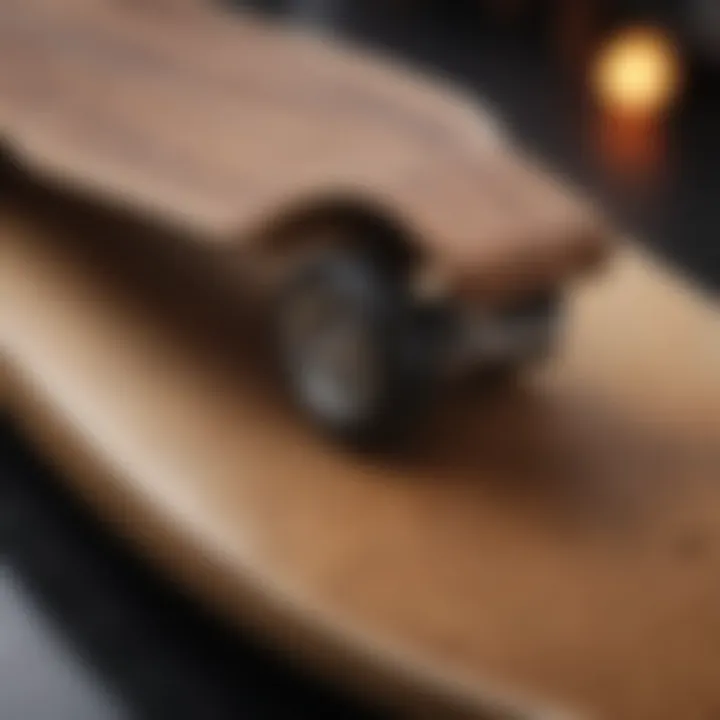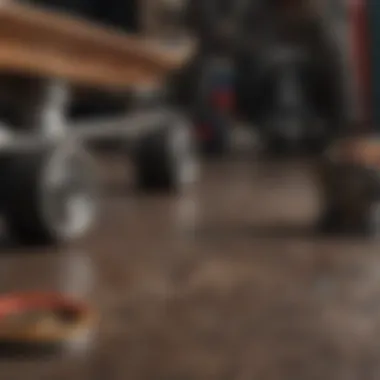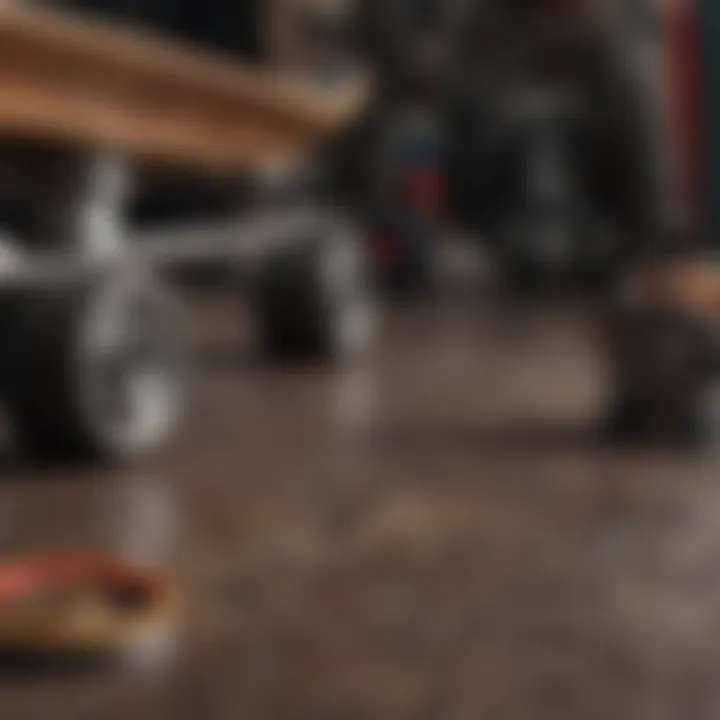The Ultimate Guide to Pintail Skateboards


Intro
Pintail skateboards represent a specific niche within the broad spectrum of skateboarding, capturing the essence of both style and function. Their distinct design features cater to various riding styles, particularly cruising and commuting. This guide delves deep into understanding the nuances of pintail skateboards, unraveling crucial factors such as construction integrity, ideal usage, maintenance guidelines, and their broader relevance in the culture of extreme sports.
Extreme Sports Overview
Definition of Extreme Sports
Extreme sports signify a category of activities that involve a certain level of inherent risk. This risk often stems from speed, height, or a combination of both. Those who engage in extreme sports tend to seek out innovative and challenging experiences, pushing the limits of physical capabilities.
History and Evolution
The roots of extreme sports can be traced back to the late 20th century, during a time when traditional sports like skateboarding began to evolve. Skateboarding, in particular, underwent significant transformation with the introduction of vertical ramps and street styles. Over the years, this development has led to the diversification of skateboarding styles, including the pintail skateboard.
Popular Extreme Sports Disciplines
Extreme sports encompasses a myriad of disciplines beyond skateboarding, such as:
- Snowboarding
- BMX cycling
- Motocross
- Surfing
- Rock climbing
Each discipline carries its own unique set of challenges and showcases the intricate relationship between athlete, environment, and equipment.
Gear and Equipment
Essential Gear for Different Sports
For skating enthusiasts, having the right gear is vital. For pintail skateboard users, some essential items include:
- A quality pintail skateboard
- Protective gear such as helmets, knee pads, and elbow pads
- Appropriate footwear for grip and comfort
Gear Reviews and Comparisons
In selecting a pintail skateboard, one must consider brand reputation and personal needs. Popular options like Landyachtz and Arbor both offer quality craftsmanship, yet their designs and intended uses can vary significantly. Catalyst Skateboards and Globe are worth exploring as well, each providing options that cater to different specifications and user experiences.
Safety Ratings and Certifications
Safety is paramount in extreme sports. Ensure your skateboard adheres to certifications like ASTM and CPSC for protective gear. Additionally, understanding weight limits and load-bearing capabilities is crucial for optimal performance.
Training and Preparation
Physical Conditioning and Fitness Tips
Engaging in regular exercise can enhance performance on a pintail skateboard. Focus on building core strength, agility, and balance through various workouts, such as:
- Yoga for flexibility
- Plyometric exercises for explosiveness
- Cardio for stamina
Mental Preparation Techniques
Mental fortitude is as important as physical readiness. Visualization techniques can help prepare for rides and potential obstacles. Meditative practices can also foster mindfulness, enabling a calm approach to new challenges.
Training Regimens for Various Sports
Participating in different types of skating can enhance skill level. Consider mixed training approaches to develop proficiency in various riding styles.
Locations and Destinations
Top Destinations for Extreme Sports
For those seeking adventure locations ideal for skateboarding, consider:
- Venice Beach, California
- The Streets of Barcelona, Spain
- The skate parks in Portland, Oregon
Travel Tips and Guides
When traveling to skateboard destinations, ensure you:


- Research local skate spots and regulations.
- Pack essential gear and safety equipment.
- Connect with local communities through platforms like Facebook and Reddit to gain insights into popular areas.
Skateboarding is more than a sport; it's a lifestyle that unites diverse cultures and communities.
By understanding the diverse elements surrounding pintail skateboards, enthusiasts can make informed decisions, enhancing both their performance and enjoyment in this thrilling sport. This exploration will provide essential insights for both novices and experienced riders alike.
Understanding Pintail Skateboards
Pintail skateboards hold a unique position in the realm of skateboarding and longboarding. Understanding these boards is crucial for both enthusiasts and beginners. Pintails are often seen as an entry point into longboarding due to their stability and ease of use. They are specially designed to offer a smooth riding experience, making them ideal for commuting, cruising, and carving. Their design has practical benefits, aiding in control and balance.
Definition and Structure
Pintail skateboards are characterized by a distinct elongated shape with a pointed nose and tail. This design not only enhances aesthetics but also contributes significantly to the riding experience. Typically, the deck is made from a combination of maple wood and bamboo, providing both durability and flexibility. The length usually ranges from 36 to 46 inches, which allows for a comfortable stance.
The width of the deck also matters. A wider deck generally allows for greater stability, making it less likely to wobble at high speeds. Trucks mounted on pintail boards are usually wider than those on a standard skateboard. This wider stance improves balance and control, particularly for beginners learning how to ride.
"The unique shape of a pintail skateboard not only reflects style but also functionality."
Historical Background
The historical significance of pintail skateboards is noteworthy. They developed alongside the longboarding movement in the late 20th century. Longboarding itself evolved from traditional skateboarding, aiming to integrate downhill racing, cruising, and carving. As riders sought more stability and comfort on longer rides, manufacturers began experimenting with different shapes and designs. This culminated in the creation of the pintail.
Initially, these boards were embraced by surfers, looking for a land-based alternative to practice their moves on, especially in flat terrains. Over time, pintail skateboards gained popularity beyond coastal regions, transitioning into urban environments. Their functional design made them ideal for commuting and casual rides. This cultural shift further established pintails as a staple in both the extreme sports community and among casual riders.
Key Features of Pintail Skateboards
The discussion of pintail skateboards is not complete without understanding their key features. These elements determine how the board performs, its usability by different riders, and its overall appeal within the skateboarding community. Key features can directly influence ride quality, maneuverability, and the skateboard's durability. For anyone considering a pintail skateboard, being aware of these aspects is vital.
Shape and Design
Pintail skateboards are characterized by their elongated, symmetrical shapes. They typically have a pointed nose and a tapered tail, creating a sleek silhouette. This design is not just for aesthetics. The elongated structure allows for improved stability, especially at higher speeds, making it a preferred choice for cruising and downhill riding. The flat decks provide enough space for comfortable foot positioning, enhancing the rider's balance.
Riders looking for a smooth ride will appreciate the design's contribution to performance. The flex, or rigidity of the board, also comes into play here. Boards with a moderate flex can absorb shock from uneven surfaces, providing a more comfortable ride. The shape of pintails lends itself well to carving, offering a dynamic experience, with tight turns and fluid movements.
Materials Used
The materials used in the construction of a pintail skateboard can significantly affect its performance and longevity. Most pintail boards are made from maple wood, offering a good balance of strength and flexibility. This wood type is known for its resilience and ability to withstand the rigors of daily use.
Some manufacturers use alternative materials, like bamboo or composite blends, that may decrease the weight of the skateboard while still ensuring durability. Additionally, using high-quality ply layers can enhance the board's overall structural integrity.
Beyond the deck, components like trucks and wheels also contribute to the overall material quality. Trucks made from aluminum tend to provide strength without excessive weight, assisting in maneuverability. Choosing durable wheels, often made from urethane, can ensure a smooth ride while providing enough traction.
Wheel Size and Hardness
The size and hardness of the wheels on a pintail skateboard are critical factors. Typical wheel diameters range from 65mm to 75mm. Larger wheels can handle rougher terrain, while smaller wheels allow for better control during tricks or tight turns.
Hardness is measured on a durometer scale, with softer wheels (78A to 83A) providing a smoother ride over bumps while absorbing shock. This allows for enhanced stability, particularly beneficial for cruising. Conversely, harder wheels (84A and above) are suited for smoother surfaces and offer improved slide capabilities.
When selecting a pintail skateboard, wheel size and hardness should align with the rider's style and the intended terrain. For those seeking versatility, a medium-sized and medium-hard wheel can offer a good balance for varied riding styles.
"Understanding the proper features of pintail skateboards enhances the overall riding experience and helps riders navigate their skateboarding journey with confidence."
Ultimately, diving into these key features allows enthusiasts and beginners alike to make informed decisions, tailoring their pintail skateboard choices to specific needs and preferences.
Performance Aspects
Understanding the performance aspects of pintail skateboards is essential for appreciating their role within the skateboarding realm. These characteristics influence not only how the board handles but also how it aligns with the riders' needs. Performance factors such as stability, comfort, and versatility define the overall experience and enjoyment of skateboarding. Each of these elements contributes to a better understanding of why pintail skateboards have developed a dedicated following among riders.
Stability and Control
Stability is a cornerstone for pintail skateboards, especially appealing to beginners who may have less experience. The long and narrow shape provides a wider wheelbase that enhances balance, allowing riders to feel secure during their rides. This stability is particularly advantageous when descending hills or navigating curvy paths. A well-designed pintail board like the Loaded Pintail offers a flex that can absorb shocks, resulting in better control over rides.
Additionally, the deck's design enables riders to carve smoothly without fear of losing traction. Riders can execute maneuvers confidently, making it suitable for both leisurely cruising and more technical riding.
Riding Comfort
Riding comfort is another critical aspect that enhances the pintail experience. The ergonomic design of these boards typically includes a slight concave shape that conforms to the rider's feet. This feature ensures a secure grip, reducing foot fatigue during longer rides. Furthermore, the use of softer wheels can contribute to a smoother experience, absorbing road imperfections.


Comfort also extends to the height of the board. Pintail skateboards often sit closer to the ground, reducing the distance riders need to fall in case of an unexpected slip. This lower ride height gives beginners increased confidence, encouraging exploration of new terrains.
Versatility Across Terrain
The versatility across different terrains is one of the standout features of pintail skateboards. They thrive on flat pavements but also adapt well to light off-road paths or rough grounds. The length of a pintail board enables riders to glide over obstacles, giving them freedom in choosing routes.
Consider how pintail boards perform differently in various settings:
- Urban Environments: Ideal for commuting, allowing for quick navigation and easy handling.
- Parks: Great for practicing tricks due to their stability and control.
- Nature Trails: While not designed for extreme terrain, they can manage lighter uneven paths that offer adventure.
**"Having the right pintail skateboard means being ready for anything, whether commuting to work or exploring a new trail."
In summary, the performance aspects of stability, riding comfort, and terrain versatility make pintail skateboards a highly valued choice among a range of riders. When combined, these features enhance the overall skateboarding experience, encouraging riders to hone their skills and enjoy their time on the board.
Choosing the Right Pintail Skateboard
Selecting the appropriate pintail skateboard is crucial for both performance and enjoyment. Each rider has unique preferences and styles, making it vital to pick a board that aligns with individual needs. The right skateboard can enhance stability, improve comfort, and ensure an overall satisfactory riding experience. Failing to consider personal factors may lead to dissatisfaction or even discourage someone from pursuing the sport further.
Assessing Your Riding Style
Understanding your riding style is a significant first step when choosing a pintail skateboard. Skaters have distinct ways of navigating terrain, which can influence the type of board that best suits them. Are you drawn to cruising leisurely along boardwalks or do you prefer weaving skillfully through urban environments? Each riding environment may require a different approach to board selection. A pintail board is generally better for relaxed cruising due to its longer and symmetrical design, offering more stability at high speeds and straight-line control. To choose wisely, riders should reflect upon how they intend to use the board.
Size Considerations
Choosing the right size of pintail skateboard is critical for achieving optimal performance. Two primary factors come into play here: weight limits and rider height, both of which significantly influence balance and control on the board.
Weight Limits
Weight limits are vital to consider. Each skateboard has a maximum weight capacity that should not be exceeded to maintain its structural integrity. Opting for a pintail skateboard with a suitable limit ensures durability and performance. If the skateboard is undersized for the rider's weight, it can lead to flexing or even breaks in the deck over time. Therefore, evaluating weight limits can help prolong the life of the board and enhance the overall riding experience, making it a wise choice.
Rider Height
Rider height is another important aspect when selecting a pintail skateboard. A taller rider might require a longer board for comfortable stance and riding control. Conversely, shorter riders might benefit from a smaller board that allows for more agility. Failing to align board length with rider height can impede performance, leading to difficulty in mastering maneuvers. Thus, this characteristic should not be overlooked when deciding on the ideal pintail skateboard.
Brand Recommendations
When it comes to selecting a pintail skateboard, some brands are recognized for their quality and performance. Brands like Arbor, Landyachtz, and Santa Cruz have established reputations in the market. Arbor skateboards are renowned for their eco-friendly materials, while Landyachtz is praised for innovative designs that cater to diverse riding styles. Santa Cruz is well-regarded for its durability and classic designs. Exploring various brands and their offerings can lead to a more informed and satisfying purchase.
Maintenance and Care
Maintenance and care for pintail skateboards is crucial for ensuring their longevity and optimal performance. Regular upkeep not only enhances the riding experience but also prevents damage that can lead to costly repairs or unsafe riding conditions. Understanding how to care for a pintail skateboard allows riders to enjoy longer sessions with confidence.
Regular Inspection
Conducting regular inspections helps in identifying any wear and tear that might affect performance. It is advisable to check the following components:
- Deck: Examine for cracks, chips, or warping. Any significant damage can compromise the structure.
- Trucks: Ensure that the bolts are tight and check for any signs of bending. A misshapen truck can lead to instability.
- Wheels: Look for signs of uneven wear and ensure they spin freely. A rough wheel can disrupt smooth rides.
Perform these inspections at least once a month or more frequently if you ride often. Noticing issues early can save time and money on repairs.
Cleaning Techniques
Keeping a pintail skateboard clean is another essential practice for maintaining its functionality. Here are some effective cleaning methods:
- Wipe the Deck: Use a damp cloth with a mild soap solution to remove dirt and grease. Avoid soaking the deck to prevent delamination.
- Clean the Wheels: Remove the wheels and wipe them with a cloth. You can soak them in soapy water if they are particularly dirty. Rinse thoroughly and dry completely.
- Trucks Care: Clean the trucks using a brush to remove dirt. Regularly check for rust and apply lubricant where necessary to ensure smooth turning.
Establishing a simple cleaning routine can drastically improve the aesthetics and functionality of your skateboard.
Repairs and Upgrades
Every skateboard will require repairs or upgrades over time. Recognizing when and how to make these updates can significantly extend your skateboard's life. Here are some common practices:
- Replacing Wheels: If wheels are worn out or if you want to change wheel hardness for different riding styles, consider upgrading.
- Truck Adjustment: Fine-tune the tightness of your trucks depending on your riding preferences. Loose trucks offer easier turning while tight trucks provide stability.
- Grip Tape Replacement: If grip tape has worn down, replacing it enhances safety by providing better traction.
In case of significant structural damage, consulting a professional can be wise. Consider upgrading to newer technologies or materials for better performance and durability.


Regular maintenance enhances the experience of riding a pintail skateboard, leading to improved performance and safety.
By integrating these maintenance practices into your routine, you will preserve your pintail skateboard's performance and enjoy a safer, more satisfying ride.
Pintail Skateboards in the Extreme Sports Culture
Pintail skateboards represent a unique niche within the broader category of skateboarding and longboarding. Their influence transcends just being a riding equipment; they embody a lifestyle and a culture that resonates with diverse communities. This section examines the role of pintail skateboards within extreme sports, focusing on their connection with longboarding, their utility as a commuting option, and their impact on skating trends.
Connection with Longboarding
Pintail skateboards are often associated with longboarding due to their elongated shape and stable design. This connection is significant for several reasons. Firstly, pintail boards are favored for cruising and downhill riding, providing a smooth ride that appeals to longboard enthusiasts. The design promotes stability at higher speeds, making them an ideal choice for riders who enjoy smooth, fluid motion.
Moreover, the functionalities of pintail skateboards enhance the longboarding experience. The wider decks allow for more foot space, which contributes to better control while riding. Riders can perform tricks or carve without feeling restricted. Therefore, as longboarding continues to grow in popularity, pintail boards maintain relevance in this trending sport.
Pintails and Commuting
Many people are adopting pintail skateboards as a reliable option for commuting. The practical design and comfortable ride ensure that riders can navigate urban environments efficiently. Pintails are particularly attractive for commuting due to their lightweight build and ease of maneuverability. Riders can travel short to medium distances without dealing with the hassles of public transportation or the challenges of driving.
Coupled with the growing interest in sustainable transportation, pintail skateboards provide an eco-friendly alternative. They offer not only a means of transportation but also a way to engage with the environment. Commuters appreciate the low maintenance costs associated with these boards, making them a financially viable option for daily use.
Influence on Skateboarding Trends
Pintail skateboards have significantly shaped trends in the skateboarding community. As the aesthetic appeal of pintails has grown, so have custom designs and graphics. Manufacturers have started producing an array of styles to cater to the diverse preferences of riders. This evolution showcases the merging of art and functionality in skateboarding design.
Further, pintail skateboards emphasize a culture of freedom and exploration. Riders are often associated with laid-back styles and leisurely rides, contributing to a subculture within extreme sports. This has encouraged new skaters to embrace the sport without the pressures of competing at high levels or mastering complex tricks.
Safety Practices for Pintail Skateboarding
Safety is vital in all forms of skateboarding, and pintail skateboarding is no exception. The shape and design of pintail boards lend themselves to unique riding experiences, often taken to varying speeds and terrains. Therefore, adopting proper safety practices can prevent accidents and injuries, enhance the skateboarding experience, and ensure that riders can enjoy their hobby to the fullest. Therefore, understanding and implementing safety measures is imperative for all skaters.
Essential Safety Gear
Helmets
Helmets are a fundamental aspect of safety gear for skateboarding. They protect the rider’s head in the event of falls or collisions. A key characteristic of helmets is the foam padding inside, which absorbs impact during accidents. This cushioning feature offers significant protection against head injuries, which can be severe or even fatal. It is evident that wearing helmets is a popular choice among skaters, as they reduce the risk of serious injury. Additionally, many helmets have ventilation systems, making them comfortable for longer rides. However, some riders might find them bulky or warm, especially in hot weather.
Protective Pads
Protective pads are another essential component of safety gear. They cover knees, elbows, and wrists, shielding these joints from scrapes, bruises, or fractures in case of falls. The key characteristic of protective pads is their ability to absorb shocks and distribute impacts across a surface area, greatly reducing the chances of injury. Skaters appreciate these pads for their supportive nature and comfort, as many modern designs are lightweight and unobtrusive. Nonetheless, if pads are not properly fitted, they may shift during rides, which hinders their protective capabilities.
Riding Etiquette
Riding etiquette is as important as safety gear. Respecting others on the path enhances the riding experience for everyone. Skaters should always be aware of their surroundings. This means looking out for pedestrians and yielding the right of way. It is essential to signal intentions, such as stopping or turning, to communicate with others effectively. Additionally, engaging in safe practices, such as not riding in crowded areas or at excessive speeds, promotes a culture of safety and respect among riders. Good etiquette not only helps prevent accidents but also fosters a positive environment within the skateboarding community.
"Safety is not just about wearing gear; it's about understanding and respecting your surroundings on the board."
Implementing safety practices and etiquette ensures that pintail skateboarding remains an enjoyable and secure experience, enabling both new and seasoned riders to thrive in their sport.
Future Trends in Pintail Skateboarding
Future trends in pintail skateboarding are crucial not just for enthusiasts, but also for manufacturers and retailers. This section will highlight the specific elements driving these trends, the benefits they offer, and important considerations for anyone involved in the pintail skateboard community.
Innovations in Design
The future of pintail skateboards lies in continuous innovation and design advancement. Modern skateboarders expect boards that not only perform well but are also visually appealing. Designers are experimenting with various shapes and constructions. Some developments include lightweight materials and adjustable wheelbases. These innovations provide improved handling and customization options for riders.
For instance, incorporating carbon fiber into skateboard decks enhances strength while significantly reducing weight. This combination leads to a more agile ride without sacrificing durability. Additionally, some brands are exploring modular designs, allowing users to swap components depending on their riding preferences.
Furthermore, technology integration is emerging in skateboard design. Smart skateboards equipped with sensors can track speed, distance, and technique. These features appeal especially to tech-savvy riders who enjoy analyzing their performance and progress.
Sustainability in Materials
Sustainability is becoming increasingly important in the skateboard industry. As concerns about environmental impact grow, manufacturers are shifting towards eco-friendly materials. This shift reflects a broader trend in consumer preferences as individuals become more aware of their environmental footprint.
Several alternative materials are gaining traction. Bamboo is noted for being both lightweight and durable. Many brands are sourcing bamboo for their decks, as it can grow rapidly and is resilient. Recycled plastics are also making headway in wheel and grip tape production, reducing waste in landfills.
The push for sustainability also includes ethical sourcing. Consumers are more likely to support brands that demonstrate responsible production practices. This not only benefits the environment but enhances brand loyalty among riders who prioritize eco-conscious choices.
“Sustainability and innovation are not just trends; they are integral to the future of skateboarding.”
Individual riders can benefit by embracing these changes. For example, investing in a sustainable board not only supports ethical production but often results in a more customized and enjoyable riding experience.
Overall, the emergence of innovative designs paired with a focus on sustainability underscores a growing understanding within the skateboard community about the importance of adapting to change.







